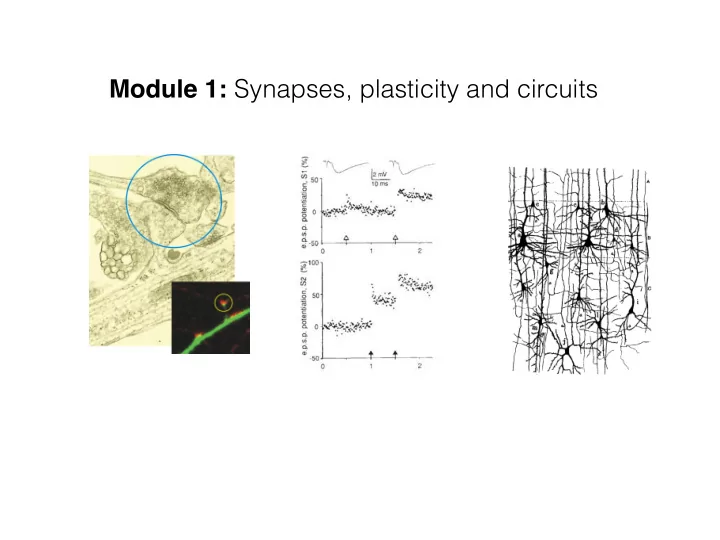

Module 1: Synapses, plasticity and circuits
The synapse: transfer of information 1 ms
The synapse: transfer of information
The synapse
The miniature postsynaptic response (or ‘mini’) Fatt and Katz, 1952 - Remain in the presence of TTX - Prolonged by blockers of acetylcholine esterase - Blocked by AChR antagonists
Quantal nature of neurotransmitter release Del Castillo and Katz, 1954
Quantal nature of neurotransmitter release
Quantal nature of neurotransmitter release Freeze fracture: vesicles caught in the act Heuser and Reese, 1981
Distinct vesicle pools Rapidly releasable pool Reserve Pool Resting Pool
The presynaptic vesicle cycle
Calcium Dependence of Neurotransmitter release 4- No calcium 3- A little more calcium 2- A little calcium 1- No calcium Katz
Caged-calcium experiments
Dependence of Neurotransmitter release on [Ca 2+ ] int Schneggenberger and Neher, nature 2000
Calcium nanodomains Neher, CONB, 1998
Postsynaptic structures
Why spines? 1- Increase surface area to optimize packing of many synapses 2- Serve as a separate electrical unit that modulates synaptic signals 3- Provide a biochemical compartment that restricts mobility of molecules
Postsynaptic structure Spines: occur at around 1-10 per um of dendrite
Synapse diversity: postsynaptic spine Matsuzaki et al., 2001 Arellano et al., 2007
Postsynaptic structure: spines Nimchinsky et al., ARN, 2002
Postsynaptic spine shape ⁄ "# $ , where L is length of neck and A is cross-sectional area R neck = and " is resistivity of cytoplasm
Spine neck can filter synaptic events Araya et al., PNAS, 2006
Postsynaptic spine shape: calcium diffusion Noguchi et al., Neuron, 2005
Molecular architecture of excitatory synapses
Glutamate-gated channels AMPAR NMDAR mGluRs GluN1-2: Tetramers of GluN1 3 groups based on pharmacology GluR1-4: Tetramers mostly of GluR2 (obligatory) and GluN2 A-D. Sequence and signalling. and two others. Calcium permeable. Group 1: mGlu1 and 5. Flip/flop: alternative splice variants Group 2: mGlu2 and 3. Q/R editing: calcium permeability Co-agonist: glycine. Group 3: mGlu4, 6, 7 and 8. Almost all GluR2 subunits are in the Blocked by Mg 2+ at rest. R form, which is Ca 2+ impermeable.
AMPA and NMDA currents
The EPSP: carried mainly by AMPA receptors Na + no mvt Inject even more K + out current ! No ion movement Inject more current Inject current to Less Na + in depolarise to -20mV Na + in Normal situation K + out recording V m No ion movement at the EPSP’s reversal potential
Glutamate postsynaptic currents
GABA A receptors
The IPSP Cl - in Normal situation recording V m No ion movement Inject hyperpolarising current Cl - Out Inject more negative current
GABA B receptors
Plasticity of synapses and transmission: mechanisms
Short Term Plasticity: heterogeneous responses to spike trains Same presynaptic neuron, different targets
Short Term Plasticity: heterogeneous responses to spike trains Different presynaptic neurons, same target
Mechanisms: Possible Sites for Modulation
Width of an Action Potential Geiger and Jonas, Neuron, 2000
Types of short-term plasticity
Facilitation at Granule to Purkinje Synapse
Facilitation and Residual Calcium Could use slow buffer (eg: EGTA) to ‘mop up’ residual calcium
Facilitation and Residual Calcium Process: high affinity, slow off rate Alturi and Regehr, J. Neurosci., 1996
Plasticity of synapses and transmission: mechanisms and functional relevance
Carew and Kandel, 1973
Carew and Kandel, 1973
Bliss and Lomo, 1973
The Organisation of Behaviour (1949) When an axon of cell A is near enough to excite cell B and repeatedly or persistently takes part in firing it, some growth process or metabolic change takes place in one or both cells such that A's efficiency, as one of the cells firing B, is increased.[3] This is often paraphrased as "Neurons that fire together wire together." It is commonly referred to as Hebb's Law.
The Organisation of Behaviour (1949) When an axon of cell A is near enough to excite cell B and repeatedly or persistently takes part in firing it, some growth process or metabolic change takes place in one or both cells such that A's efficiency, as one of the cells firing B, is increased.[3] This is often paraphrased as "Neurons that fire together wire together." It is commonly referred to as Hebb's Law.
Recommend
More recommend